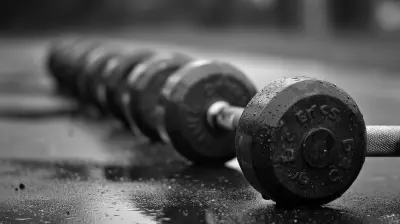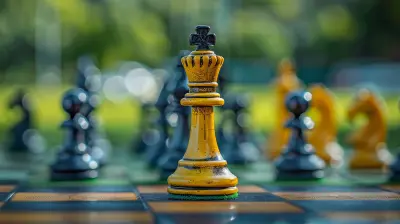How Fighters Recover Between Rounds: Secrets of the Cage
2 June 2025
Mixed Martial Arts (MMA) isn’t just about brute strength and flashy knockouts. It’s a game of skill, endurance, and strategy. And if you’ve ever watched a fight closely, you’ll know that what happens between rounds is just as crucial as the action inside the cage. Fighters have just 60 seconds to recover, reset, and adjust. So, how do they manage to bounce back so quickly? Let's dive into the secrets of fighter recovery between rounds and see what it takes to keep going in the most intense sport on the planet.

The Importance of Recovery Between Rounds
Think about it—after three or five minutes of non-stop action, a fighter’s body is screaming for a break. Their heart is pounding, lungs are burning, muscles are fatigued, and their mind is trying to process everything that just happened. That 60-second break is like a reset button, giving them a shot at coming back stronger in the next round.But how fighters recover in that short period isn’t just about sitting on a stool and catching their breath. There’s a science to it, and the best fighters know how to maximize every second to ensure they’re ready for whatever comes next.

Breathing: The Foundation of Recovery
One of the first things any fighter needs to focus on between rounds is their breathing. You’ve probably seen it—fighters sitting on their stool, heaving, sucking in air like it’s the last thing on earth. But uncontrolled breathing isn’t helpful. If a fighter doesn’t regulate their breathing, they’ll end up more exhausted than when the round ended.Coaches often remind their fighters to take deep, controlled breaths through the nose and out through the mouth. This technique helps to slow down the heart rate and bring oxygen back into the muscles. It’s like rebooting a computer—if you don’t give it a proper shutdown, it’ll crash.
Why Is Controlled Breathing So Important?
When a fighter controls their breathing, it allows their body to calm down faster. Think of it like a car engine—after you’ve been racing down the highway, you can’t just slam on the brakes and expect everything to cool off instantly. You have to ease into it, and that’s what controlled breathing does for the body.By focusing on deep breaths, fighters can clear out some of the lactic acid buildup in their muscles, reducing the risk of cramps or muscle fatigue. This also helps clear the mind, allowing fighters to focus on the next round rather than dwelling on the punches they just took.

The Role of the Corner Team
While the fighter is catching their breath, the corner team is hard at work. These guys are like a pit crew in a Formula 1 race—they have a limited window to get the fighter back in peak condition. Whether it’s wiping down sweat, applying ice, or giving strategic advice, every second counts.Physical Maintenance
First up, the corner team will likely apply cold compresses or ice packs to the fighter’s body, focusing on the chest, back, and neck. This helps bring down body temperature and reduce swelling. You might also see them applying ice to the face, especially if the fighter has taken a few hard shots. Cuts, bruises, and swelling are part of the game, and the faster you can manage them, the better.You’ll also notice that some corners will massage or shake the fighter’s arms and legs. This isn’t just to keep them loose—it’s about breaking up any tension that’s built up in the muscles. A tight muscle can mean slower reaction times, and in a sport where milliseconds count, that could be the difference between winning or getting knocked out.
Mental Reset
Beyond the physical aspect, the corner is also there to give the fighter the mental boost they need. Whether it’s offering technical advice, reminding them of the game plan, or simply shouting words of encouragement, the corner is essentially the fighter’s eyes and ears.A good corner team knows how to strike the right balance between motivating the fighter and keeping them calm. Sometimes all it takes is a few well-placed words to help a fighter regain their focus and confidence. It’s like having a coach in your corner during a boxing match—except this coach is also your therapist and your biggest cheerleader.

Hydration and Energy Boosts
During those 60 seconds, hydration is critical. Fighters sweat buckets during a round, and with that sweat goes essential electrolytes. Without replenishing those, a fighter can quickly hit a wall of fatigue, making them slower and less responsive.Water alone doesn’t cut it. Many fighters will sip on electrolyte-enhanced drinks to quickly restore the balance of sodium, potassium, and magnesium in their bodies. Some corners even use specific energy gels or supplements to give fighters a quick glucose hit, giving them that extra push they need.
What About the Famous "Cold Water Dump"?
You’ve probably seen fighters getting water poured over their heads between rounds. It’s not just for show. A quick splash of cold water can help lower body temperature and give the fighter a refreshing wake-up call. It’s like throwing cold water on your face in the morning—it snaps you right into focus.Managing Damage: Cuts, Bruises, and Swelling
MMA is a brutal sport, and it’s almost guaranteed that a fighter will accumulate some damage during a fight. Between rounds, the cutman becomes the fighter’s best friend. This person’s job is to minimize the damage and keep the fighter from being too impaired to continue.The Cutman’s Toolkit:
- Vaseline: Applied to the face to help prevent further cuts from getting worse.- End-Swell: A cold metal instrument used to press down on swelling, especially around the eyes.
- Adrenaline or Coagulants: Applied to cuts to stop the bleeding.
The cutman has less than a minute to get things under control. If a fighter has a cut that’s bleeding heavily, the cutman needs to stop it fast, or the referee might step in and stop the fight. It’s high-stakes, high-pressure work.
Psychological Recovery: The Mind Game
Recovering between rounds isn’t just about the body. The mind plays a massive role in a fighter’s performance. You could be the most physically fit athlete in the world, but if your mental game is off, you’re in trouble.Fighters use this brief period to shake off any doubts, fear, or frustration. Whether it’s calming the nerves after a tough round or psyching themselves up for the next one, mental toughness is key. You’ll often see fighters staring intensely at their opponents or taking a moment with their eyes closed to reset their focus. It’s like a mental deep breath before jumping back into the fire.
The Role of Experience
It’s not just the corner team or external factors that help a fighter recover. Experience plays a huge role. Veteran fighters know their bodies inside out. They know how to pace themselves during a fight, which allows them to conserve energy and recover more efficiently between rounds.Less experienced fighters might burn out early by going all out in the first round. By the time they hit the stool, they’re already spent. Experienced fighters, on the other hand, know how to pick their moments. They understand when to push and when to hold back, ensuring they have enough gas left in the tank for the later rounds.
The Final Push: Coming Out Strong
When the bell rings, it’s go time. Everything that happens in that 60-second window is designed to give the fighter the best possible chance of success in the next round. They’ve taken a breath, hydrated, iced down, listened to their corner, and reset their mind. Now it’s time to put it all into action.A fighter who can recover effectively between rounds has a massive advantage. They’re fresher, sharper, and more focused. In contrast, a fighter who can’t recover is like a car running on fumes—they might keep going for a bit, but sooner or later, they’ll stall out.
Conclusion: The Science Behind the Seconds
In MMA, the space between rounds can be the difference between victory and defeat. It’s an intricate balancing act of physical recovery, mental reset, and strategic adjustments. Fighters, with the help of their corner teams, use every second to regain their strength, clear their minds, and prepare for the next battle.So, the next time you’re watching a fight, pay close attention to what happens when the bell rings and the fighters head back to their corners. It’s not just a break—it’s a carefully orchestrated routine that could make or break the outcome of the fight. The secrets of the cage lie not just in the punches thrown but in the critical moments of recovery that follow.
all images in this post were generated using AI tools
Category:
MmaAuthor:

Everett Davis
Discussion
rate this article
3 comments
Myles Webster
Great insights on the recovery techniques fighters use between rounds! Understanding their strategies not only enhances our appreciation for the sport but also emphasizes the importance of mental and physical resilience. Looking forward to more articles that delve deeper into athlete preparation and performance!
June 20, 2025 at 11:19 AM

Everett Davis
Thank you! I’m glad you found the insights valuable. Stay tuned for more articles exploring athlete preparation and performance!
Selene Weber
Recovery is just as vital as the fight itself! The secrets shared here remind us that resilience and strategy off the mat are key to victory in the cage!
June 10, 2025 at 2:43 AM

Everett Davis
Absolutely! Recovery is essential for peak performance and winning strategies in the cage.
Dominic Nguyen
Great insights on fighter recovery! Understanding the importance of mental and physical resets between rounds really highlights the dedication and strategy involved in combat sports. Keep up the fantastic work in bringing these secrets to light!
June 3, 2025 at 10:46 AM

Everett Davis
Thank you for your kind words! I'm glad you found the insights valuable. Recovery is indeed crucial in combat sports. Stay tuned for more!



